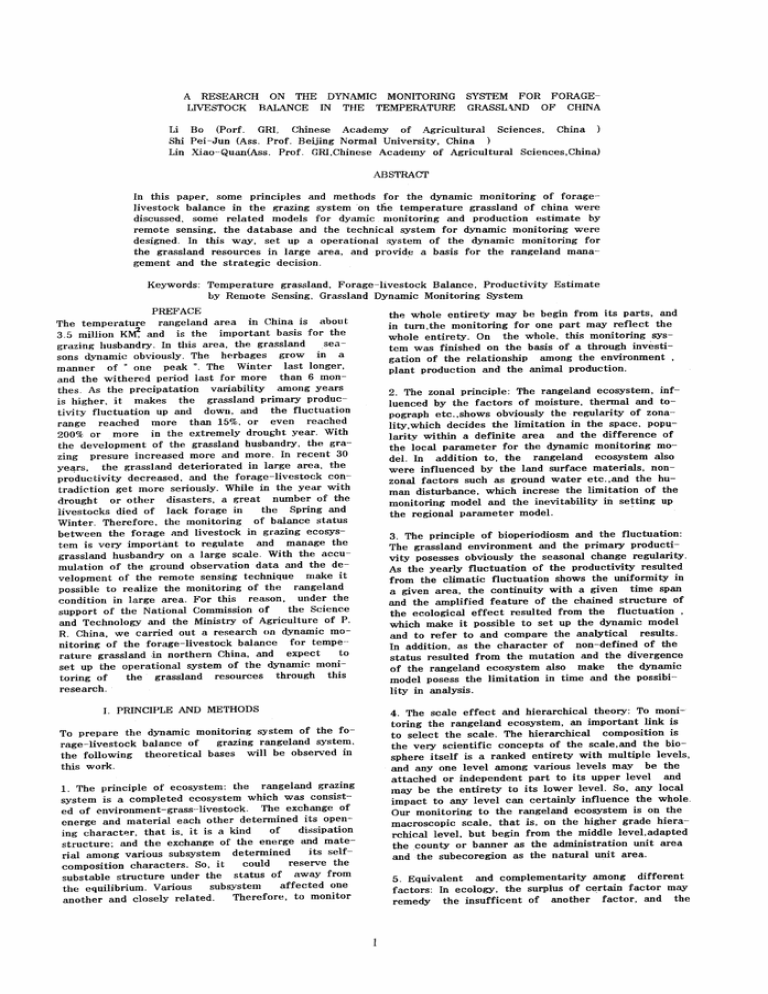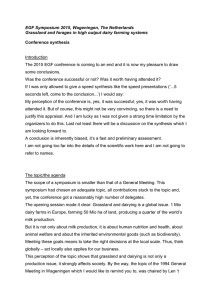A RESEARCH ON THE DYNAMIC ... LIVESTOCK BALANCE IN
advertisement

A RESEARCH ON THE DYNAMIC MONITORING
LIVESTOCK BALANCE IN THE rrEMPERATURE
SYSTEM FOR FORAGEGRASSLrnD OF CHINA
Li Bo (Porf. GRI, Chinese Academy of Agricultural Sciences, China
Shi Pei-Jun (Ass. Prof. Beijing Normal University, China )
Lin Xiao--Quan(Ass. Prof. GID,Chinese Academy of Agricultural Sciences,China)
ABSTRACT
In this paper, some principles and methods for the dynamic monitoring of forage-livestock balance in the grazing system on the temperature grassland of china were
discussed, some related models for dyamic monitoring and production estimate by
remote sensing, the database and the technical system for dynamic monitoring were
designed. In this way, set up a operational system of the dynamic monitoring for
the grassland resources in large area, and provid~ a basis for the rangeland management and the strategic decision.
Keywords: Temperature grassland, Forage-livestock Balance, Productivity Estimate
by Remote Sensing. Grassland Dynamic Monitoring System
PREFACE
The temperature rangeland area in China is abou t
3.5 million K~ and is the important basis for the
grazing husbandry. In this area, the grassland
seasons dynamic obviously. The berbages grow in a
manner of" one peak ". The Winter last longer,
and the withered period last for more than 6 monthes. As the precipatation variability among years
is higher, it makes the grassland primary productivity fluctuation up and down, and the fluctuation
range reached Tllore than 15%. or even reached
200% or more in the extremely drought year. With
the development of the grassland husbandry, the grazing presure increased more and more. In recent 30
years, the grassland deteriorated in large area, the
pro'ductivity decreased, and the forage-livestock contradiction get more seriously. While in the year with
drought or other disasters, a great number of the
livestocks died of lack forage in
the Spring and
Winter. Therefore, the monitoring of balance status
between the forage and livestock in grazing ecosystem is very important to regulate and manage the
grassland husbandry on a large scale. With the accumulation of the ground observation data and the development of the remote sensing technique make it
possible to realize' the monitoring of the rangeland
condition in large area. For this reason, under the
support of the National Commission of
the Science
and Technology and the Ministry of Agriculture of P.
R. China, we carried out a research on dynamic monitoring of the forage-livestock balance for tempe-rature grassland .in northern China, and expect
to
set up the operational system of the dynamic monitoring of
the grassland resources through this
research.
1. PRINCIPLE AND METHODS
To prepare the dynamic monitoring system of the forage-'livestock balance of
grazing rangeland system.
the following theoretical bases will be observed in
this work.
1. The principle of' ecosystem: the rangeland grazing
system is a completed ecosystem which was consisted of environment-grass--livestock. The exchange of
energe and material each other determined its opening character, that is. it is a kind
of
dissipation
structure; and the exchange of the energe and material among various subsystem determined
its selfcomposition characters. So, it
could
reserve the
substable structure under the status of away from
the equilibrium. Various
subsystem
affected one
another and closely related.
Therefore, to monitor
the whole entiretY may be begin from its parts, and
in turn,the monitoring for one part may reflect the
whole entirety. On the whole, this monitoring system was finished on the basis of a through investigation of the relationship among the environment
plant production and the animal production.
2. The zonal principle: The rangeland ecosystem, influenced by the factors of moisture, thermal and topograph etc.,shows obviously the regularity of zonality,which decides the limitation in the space, popularity within a definite area and the difference of
the local parameter for the dynamic monitoring model. In addition to, the rangeland ecosystem also
were influenced by the land surface materials, nonzonal factors such as ground water etc. ,and the human disturbance, which increse the limitation of the
monitoring model and the inevitability
setting up
the regional parameter model.
in
3. The principle of bioperiodiosm and the fluctuation:
The grassland environment and the primary productivity posesses obviously the seasonal change regularity.
As the yearly fluctuation of the productivity resulted
from the climatic fluctuation shows the uniformity in
a given area, the continuity with a given time span
and the amplified feature of the chained structure of
the ecological effect resulted from the fluctuation.
which make it possible to set up the dynamic model
and to refer to and compare the analytical results;
In addition, as the character of non-defined of the
status resulted from the mutation and the divergence
of the rangeland ecosystem also make the dynamic
model posess the limitation in time and the possibility in analysis.
4. The scale effect and hierarchical theory: To monitoring the rangeland ecosystem, an important link is
to select the scale. The hierarchical composition is
the very scientific concepts of the scale,and the biosphere itself is a ranked entirety with multiple levels,
and anyone level among various levels may be the
attached or independent part to its upper level and
may be the entirety to its lower level. So, any local
impact to any level can certainly influence the whole.
Our monitoring to the rangeland ecosystem is on the
macroscopic scale, that is, on the higher grade hierarchical level, but begin from the middle level,adapted
the county or banner as the administration unit area
and . the subecoregion as the natural unit area.
5. Equivalent and complementarity among different
factors: In ecology, the surplus of certain factor may
remedy the insufficent of another factor, and the
h: altitude
Attribution:
A = 1[1'.
<attribution K, value types K >
k::,
The database structure can be defined as:
n In l'
..(i)
(tlO)
(i)()l
D = 1T IT TI <Ti, <SJ, <attribution" value types k "»>
The da\~ fecord can be defined· a~:
R =
<value i, valuJit valu~(;)k »>
different things may
posses the equivalance. In the
rangeland monitoring, the amount of the biomass may
be expressed by the spectrum value, and as the fog
overcasting, any part of surface where lack of spectrum value may be replaced with the geographical
model, so; a set
of completed data for the same
time span in a large area also may be derived.
Under the directions of the above principles, we adapted the technical thread by combining the ground
investigation, statistical data and the remote sensing
data, combining the geographical model, remote sen.sing model and the
biological moel, and combining
the digital output and the image output, and adapted the methods of entirety designing and preparing
respectively .
nnrt
i j K
m. THE DYNAMIC MONITORING MODEL
In setting up the dynamic monitoring system of the
balance, the model playa very
important role. Because the model is the tools for
information analysis, and also the basis for setting
up opera~ional monitoring system. In this monitoring ·system, several types of the model are to be
used as the fonowing:
forage~livestock
II. THE MONITORING INFORMATION AND THE DATA
BASE
1. The geographical
model for grassland productivity estimate(climatic model):
W = f ( p" , T , L, H)
P = f (7\) ct ,h)
Tj = f (~J l' .h)
Tp = f (1\. /P, h)
Where, W : above-ground biomass
P : rainfun· during the growing seasons
Tj: accumulation temperature ()IOC) during
the growing seasons
Tp: the sum of month mean temperature
during the growing seasons
7\..: latitude
ct: IQgitude
h: altitude
L: soil status
H: man management level
When given the soil status (L) and the man management levels (H), then:
Wj = f (P, Tj)
Wp =c f (P, Tp)
1. The information types: This monitoring system is
a kind of GIS. Its
monitoring information includes
three categories:· attribute information(statistics information) , thematic information and the remote sensing information.
(1). Attribute information: includes climatic data,
disaster statistics, livestock husbandry statistical
data, ground investigation and the observed data,
population and the social and economy statistics
data etc.
(2). Thematic information: The thematic information may express the spacial pattern, including
the information maps of natural unit and the administration unit, such as landform map, administration regional map, land use map, rangeland-types
map, ecological regionalization map etc ..
(3). Remote sensing information: The main information sources are the information from NOAA-AVHRR,
GMS, FengYun-I satellite and the Landsat.
2. The Data Structure:The above-information can be
divided into historic and. real-time information according to the time axle, and these information can
be sum up a kind of three-dimision information space by complex the above-information with the geographic space.(as shown in the following FIG.I).
2. The optical model for grassland productivity estimate ( remote sensing model )
Ground determination:
gi = fi ( chI, ch2 )
Wg = fi ( gi )
Where: i=l,2, two kinds of calculating model.
chI: the channell of the ground determinating optical spectrum
ch2: the channel 2 of the ground determinating optical spectrum
gi: vegetation index of the optical spectrum of the ground determinated according to the ith calculating model.
Wg: gro~nd investigation grassiand production
The corresponding model of the remote sensing optical spectrum:
Gi=f(gi)
Where, Gi: vegetation index of satellite remote sensing according to the ith calculating model
The production-estimate model of remote sensing:
Ws = fi (Gi)
Where: Ws is the grassland production hy remote
sensing according to the ith calculating model.
The model test: using the statistical-test methods,
ATTRmUTION (A)
SPACE (S) /
k(Tl
The above information space can be defined as follows:
t+At (future)
Time:
T =
t (real time)
{
t -At (historic)
The geographic position: S
< A. ,q, , h >
A: logitude
1>: latitude
P<O.05.
2
3. The comprehensive model of the grassland production estimate
The geographical model, as a reflection of mean
status of the grassland productivity, could not sufficiently express the influences of non-zonal factors,
and the remote sensing model is easy to be influenecd by the meteological factor, plant life-form and
the vegetation coverage etc. While combine these
two aspects, the preCISIOn of production estimate
can be lifted, and conform to the demand for setting up the operational dynamic monitoring system.
The comprehensive assessing model can be expressed
in the following concept equation:
P == a Wg + a Ws
Where: a and a are weighted coefficient.
IV. THE TECHNICAL SYSTEM OF THE DYNAMIC
MONITORING
The structure of the monitoring 'system of foragelivestock balance for the temperature grassand is as
Fig. 2.
4. The grassland utilization model
In order to calculate the balance between forage
and livestock, it needs to reckon the available
part of the grassland biomass, which were different in terms of livestock types, grassland types
and the utilization seasons. The model concepts can
be expressed in equation:
U == f(Si, Ai, Wi, U (max»
Where U: The uti;lization ratio by j animal to
type
of grassland in the given time.
gi: area of i type of grassland.
Aj: number of j animal.
t: season or time .
Wi: aboe~ground biomass of i grassland in the
given time.
U (max): maxmum utilization ratio of j animal
to i type grassland.
Fig.2 The technical system of the dynamic monitoring
'5. Model of balance between forage and livestock
B = f ( W, R, t ) - ( U, A, t )
Where, B: balance between forage and livestock
W: grass production
R: regrowth
intensity of the herbages
U: ,utilization amount of the herbage by
herbivore
A: number of the herbivores
t: time
1. The command control center
The system operation was controled and operated by
the command center. it determined the commands
flow for the goal analysis according to the received
tasks, and realize the operation aDd control for various subsYstem, and in the same time, undertake
the task of monitoring, recording and revising for
the system operation status. It was realized by adapting the man-machine dialogue medium with sensitively and conveniently and the computer network
system.
In this structure diagram, the fat fold line represents
the command flow, the thin line represents the data
flow. The square fram represents the functioning
models and the buffer-shaped rep resets the database
or analytical tool box.
6. the complex calculating model of the multiple information
The model-chains mould in the processing of the
multiple information
7. System management and
2. The information extracting subsystem: In terms of
sources, forms and extracting method, the informa"':'
tion can be divided into three parts:
(1). The information of ground monitoring: The
ground monitoring include
meteological observation, phenological observation, productivity assess'ment, ecological environment monitoring ( land sandification, deterioration, water and soil erosion, moisture change etc. ), resources utilization status monitoring, disasters monitoring etc ..
(2). Statistical data and the thematic map: The
thematic map mainly includes: administration regionalization map, grassiand types map, ecological regionalization map, land use map, landform map etc.
the control pattern
(1) operation commands system
(2) system dynamic monitoring
(3) system modelling
(4) the correction of the variables and the parameter
8. System intelligent model
(1) auto-distinguishing expert system
(2) the grassland environment quality and suitability
evaluating expert system
(3) the grassland water and soil conservation expert
system
3
'l'he statistical data mainly includes: agriculture statistical data ( production facilities, livestock structure and numbers ), the social and economy statistical data, disasters statistical data etc ..
(3) Remote sensing information
Including the meteriological satellite receiving system and the Image processing system. The image
processing system receive the original spectrum information from the satellite receiving system according to the operation commands and demands
from the command center, and extracting the necessary analysis method from the analytical tool box,
and if necessary, check the required attribute information by the database management subsystem,
and process and calculate the original spectrum
information, sort out the corresponding remote sen
sing information and pass them to the database managemant subsystem.
gement subsystem and by the concerned analytical
tools. In addition to setting up the models, the
model management subsystem carry out the managements according to the proviously types and diffinations of the models and provide the operations of
check, look, delete,edit,update etc. for the models.
The model box can not only provide analysis models
for the digital calculation. but also provide the logistic modelling models of the non-digitai calculation
for the changing borders and changing parameters.
(2). The intelligent analytical processing methods:
These mainly composed of various expert systems,
e.g. the self-distinguishing expert system of the
grassland types, the estimating expert system for
the grassland environment quality suitability, the
grassland water and soil conservation expert system
etc. The intelligent model assists the analysis in
order to solve some problems which concerned multiple factors, complex relationships and which is
with sophisticated entirety or comprehension and of
which it is difficult to process better with other
analytical means.
3. Information management subsystem
The main task of the information management subsystem is to pack the information into the database
fram which have been designed according to given
data mould structure, and form the database with
uniformity record format. On the other hand, to
pack the remote sensing infonnation into the remote
sensing map box in the form of phaseposition, and
attribute, as the style of documents. In addition,
the information management subsystem can provide
the operation of look, check. delete, edit, update
and usual calculation etc. for the records and map
with multiple forms ( including logistic form), and
can sensitively alternate the calculation for the
attribute and image.
5. The information communication and transmission
After sorting, the goal analytical results were transmissioned to management or strategic departments
or other users according to given formats (maps,
texts, tables etc.) by means of micro-weave communication facilities (fax, telegram etc.) or the satellite communication technology.
V. SUMMARY
The above technical system and the models, after
testing on the typical area of Inner Mongolia rangeland, proved to be feasible. Using the NOAA-AVHRR
data, the precision for the grassland production estimate can reached more than 95%. So, setting up
the dynamic monitoring system of the rangeland resources for large area, can fully satisfied the de-mand of the grassland macroscopic management.
4. The information processing subsystem: its task is
to po cess the information by the machanical operation model or the intelligent model according to the
management aims, and get the results used for the
management departments or other users, and pass
the information to the information transmission subsystem after sorting, in the same time, save to the
database. In this process, the aims was given by
users. Untill now, the system can provide three analytical aims:(1) The grassland productivity estimate,
(2) The evaluation on the forage-livestock balance
of the grazing rangeland system. (3) The grassland
disasters estimation.
The information processing can be divided into two
methods:
(1). The mechanical model processing method:
According to the analytical goals, the model management subsystem transfer concerned analytical model from the database adopted by the model mana-'
REFERENCES
Li Bo et al.1990.The Steppe of China, Science Press
T. F. Allen and Starr T. B. 1982. HierarchY: Perspectives for Ecological Complexity. Univ. of Chicago Press, pp. 310
Chen Shu·-Peng, 1990. Remote Sensing Monitoring and
Forecasting of The Natural Environment Vicissitudes.
Remote Sensing Utilization. The Exploration of The
Geography, Vol. 3. pp. 124-129. Science Press
Xu Guan-Hua et al. 1988. The Expert System for
Distinguishing Remote Sensing Image, Remote Sensing Research on the Regrowth Resources, Science
Press, pp. 38-47.
4






